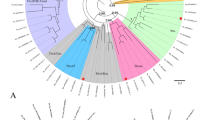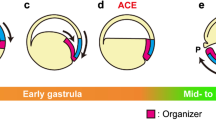Summary
Cell-cell interactions during the development of bud polarity in the polystyelid ascidianPolyandrocarpa misakiensis were studied by juxtaposing normally nondjacent bud pieces from marked stocks. These chimeras have been used to determine the prospective fate of each bud piece with respect to positional disparity. The results showed that the posterior end of a future zooid was always established around the proximal boundary region of the two bud pieces. The anteroposterior axis was skewed from this posterior end toward the bud piece arising from a lower (more anterior) level of the parental zooid, suggesting that the lower level tissue may provide a cue which establishes the site of the future anterior end. The role of positional disparity between bud pieces was further examined by sandwiching a host bud between two grafts of various parental positions. The results showed that an additional positional gap resulted in the formation of an additional posterior structure such as the digestive tract. For example, when the grafts were taken from two or more positions posterior to the host bud, biposterior zooids were induced in 20–30% of the cases. This induction ratio increased to 72.4% if two host buds were used instead of a single host. It is, therefore, concluded that the gap of positional values in ascidian buds triggers the formation of the posterior-most positional value. This cellular response to a positional gap contrasts with the intercalation theory that is predicted by the polar coordinate model for pattern formation.
Similar content being viewed by others
References
Abbott DP (1953) Asexual reproduction in the colonial ascidianMetandrocarpa taylori Huntsman. Univ. Calif Publ Zool 61:1–78
Berrill NJ (1940) The development of a colonial organism:Symplegma viride. Biol Bull 79:272–281
Berrill NJ (1941a) The development of the bud inBotryllus. Biol Bull 80:169–184
Berrill NJ (1941b) Size and morphogenesis in the bud ofBotryllus. Biol Bull 80:185–193
Bryant PJ (1978) Pattern formation in imaginal discs. In: Ashburner M, Wright TRF (eds) The genetics and biology ofDrosophila, vol 2c. Academic Press, New York, pp 229–335
Bryant SV, Iten LE (1976) Supernumerary limbs in amphibians: Experimental production inNotophthalmus viridescens and a new interpretation of their formation. Dev Biol 50:212–234
Bryant SV, French V, Bryant PJ (1981) Distal regeneration and symmetry. Science 212:993–1002
Freeman G (1964) The role of blood cells in the process of asexual reproduction in the tunicatePerophora viridis. J Exp Zool 156:157–184
Freeman G (1970) The reticuloendothelial system of tunicates. J Retic Soc 7:183–194
French V, Bryant PJ, Bryant SV (1976) Pattern regulation in epimorphic fields. Science 193:969–981
Gierer A, Meinhardt H (1972) A theory of biological pattern formation. Kybernetik 12:30–39
Hicklin J, Hornbruch A, Wolpert L (1975) Positional information and pattern formation inHydra. Dynamics of regions away from the boundary. J Embryol Exp Morphol 33:511–521
Holder N, Tank PW, Bryant SV (1980) Regeneration of symmetrical forelimbs in the axolotl,Ambystoma mexicanum. Dev Biol 74:302–314
Izzard CS (1973) Development of polarity and bilateral asymmetry in the palleal bud ofBotryllus schloseri (Pallas). Morphol 139:1–26
Kawamura K, Watanabe H (1982a) Localized morphogenetic activity in the palleal bud of a polystyelid ascidian,Polyandrocarpa misakiensis. I. A histological study. Mem Fac Kochi Univ Ser D 3:55–69
Kawamura K, Watanabe H (1982b) Pattern development in palleal buds of botryllid ascidians: Relation between parent and its buds in their body axes. J Morphol 173:293–304
Kawamura K, Watanabe H (1982c) Pattern development in palleal buds of the polystyelid ascidian,Polyandrocarpa misakiensis: Bud grafting induces bilateral asymmetry conversion through polarity reversal. J Exp Zool 224:145–156
Kawamura K, Watanabe H (1983) The role of parental positional information in the determination of anteroposterior polarity during palleal budding in ascidians. Wilhelm Roux's Arch 192:28–36
MacWilliams HK (1982) Pattern formation in hydra head regeneration. Am Zool 22:17–26
Milkman R (1967) Genetic and developmental studies onBotryllus schlosseri. Biol Bull 132:229–243
Müller WA (1982) Intercalation and pattern regulation in hydroids. Differentiation 22:141–150
Oka H, Watanabe H (1957) Colony-specificity in compound ascidian as tested by fusion experiments. Proc Jpn Acad 33:657–659
Rubin DI, Bode HR (1982) Theabberant, a morphological mutant ofHydra attenuata, has altered inhibition properties. Dev Biol 89:316–331
Sabbadin A (1955) Osservazioni sullo sviluppo, l'accrescimento e la riproduzione diBotryllus schlosseri (Pallas), in condizioni di laboratorio. Boll Zool 22:243–263
Sabbadin A (1969) The compound ascidianBotryllus schlosseri in the field and in the laboratory. Pubbl Staz Zool Napoli [suppl] 37:62–72
Sabbadin A (1978) Genetics of the colonial ascidian,Botryllus schlosseri. In: Battaglia B, Beardmore J (eds) Marine organisms. Plenum Press, New York, pp 195–209
Sabbadin A, Zaniolo G (1979) Sexual differentiation and germ cell transfer in the colonial ascidianBotryllus schlosseri. J Exp Zool 207:289–304
Sabbadin A, Zaniolo G, Majone F (1975) Determination of polarity and bilateral asymmetry in palleal and vascular buds of the ascidianBotryllus schlosseri. Dev Biol 46:79–87
Scofield VL, Schlumpberger JM, West LA, Weissman IL (1982) Protchordate allorecognition is controlled by a MHC-like gene system. Nature 295:499–502
Sugimoto K, Nakauchi M (1974) Budding, sexual reproduction, and degeneration in the colonial ascidian,Symplegma reptans. Biol Bull 147:213–226
Sugiyama T (1982) Roles of head-activation and head-inhibition potentials in pattern formation ofHydra: Analysis of a multiheaded mutant strain. Am Zool 22:27–34
Tank PW (1978) The failure of double-half forelimbs to undergo distal transformation following amputation in the axolotl,Ambystoma mexicanum. J Exp Zool 204:325–336
Tank PW (1979) Positional information in the forelimb of the axolotl: Experiments with double-half tissues. Dev Biol 73:11–24
Watanabe H, Takioka T (1972) Two new species and one possibly new race of social styelids from Sagami Bay, with remarks on their life history, especially the mode of budding. Publ Seto Mar Biol Lab 14:327–345
Watterson RL (1945) Asexual reproduction in the colonial tunicate,Botryllus schlosseri (Pallas) Savigny, with special reference to the developmental history of intersiphonal bands of pigment cells. Biol Bull 88:71–103
Wolpert L, Hornbruch A, Clarke MRB (1974) Positional information and positional signalling inHydra. Am Zool 14:647–663
Author information
Authors and Affiliations
Rights and permissions
About this article
Cite this article
Kawamura, K. The mechanism of anteroposterior cell determination in ascidian palleal buds: A gap of positional values triggers posterior formation. Wilhelm Roux' Archiv 193, 24–35 (1984). https://doi.org/10.1007/BF00848597
Received:
Accepted:
Issue Date:
DOI: https://doi.org/10.1007/BF00848597




